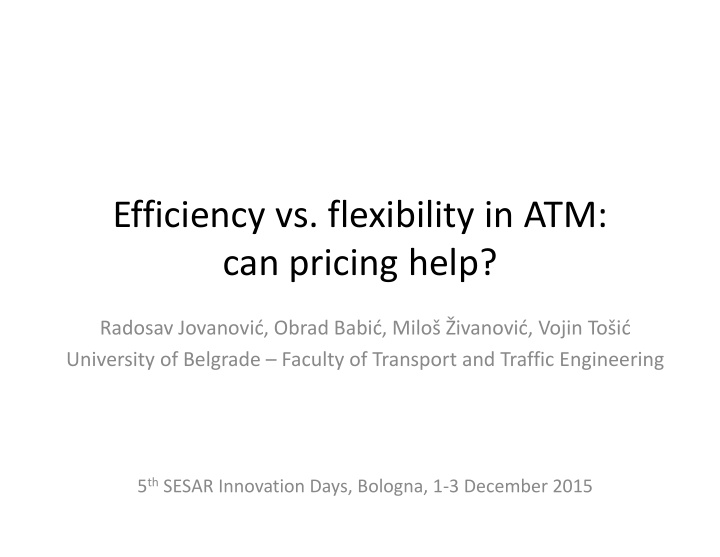



Efficiency vs. flexibility in ATM: can pricing help? Radosav Jovanovi ć , Obrad Babi ć , Miloš Živanovi ć , Vojin Toši ć University of Belgrade – Faculty of Transport and Traffic Engineering 5 th SESAR Innovation Days, Bologna, 1 ‐ 3 December 2015
Motivation: circulus vitiosus? Uncertainties faced by AUs during flight planning (wind, payload, turbulence, schedule disruptions…) AUs exercise late submission of flights plans, looking for “last minute” route choice gains (“flexibility”) Additional uncertainty generated, imposed on ANSPs and the network manager Deteriorated network performance (including extra cost for AUs and potentially unfair distribution thereof)
ANSP perspective and implications for AUs • What would ANSPs prefer: “a more consistent delivery across the network in order to optimise available capacity and to reduce periods of over ‐ delivery and overloads” • “The more imprecise the projected traffic loads for airspace sectors prove to be, the bigger the safety margins will have to be which are built into their declared capacity limits” [Skyguide, Head of ATFCM] • The cost of additional resources employed thus, everything else equal, attributable to poor traffic predictability.
Idea: pricing to reward predictability (RP) • “Predictability” = reduction of demand ‐ driven uncertainty. • Improved predictability might yield cost savings, which could be passed on to AUs. • Offer AUs incentives to reduce uncertainty imposed on ANSPs/NM. • How: coordinated network pricing, including the intertemporal dimension, to reward earlier filing of flight intentions. • Three ‐ dimensional differential pricing (time of use, location of use, and time of purchase) and first ‐ come, first ‐ choice discipline.
Key mechanism assumptions • Users are offered and are free to choose their route from a menu of routes offered by a central body, e.g. from a set of typically used trajectories per OD pair. • A menu of routes for a given OD pair and a given date and departure time is a dynamic category. • The initial menu of routes contains the broadest set of offered routes. • The price of a given 4D route at any given moment is calculated as the sum of prices attached to network segments forming that route. • No refund.
Mechanism algorithm • Four route options per flight on average, including re ‐ routings and at ‐ gate delays. The cost of the route option includes the “displacement” cost plus • the cost of associated route charges. – “Displacement cost” = the cost of deviation from the “reference” route • Sector ‐ period charge = Base tariff x M1 x M2 x M3 • Route choice rule: – Deterministic (RP ‐ D): each flight assumed to choose the least ‐ cost route option offered. – Stochastic (RP ‐ S): replicates (on aggregate) AUs’ behaviour as described by Delgado (2015)
Multipliers • M1 rewards early route purchases crossing airspace controlled by a given ANSP – dynamic, varies per ANSP ‐ period (period = 30 minutes) • M2 is the function of the cumulated number of flights in the given sector ‐ period , resulting from already completed route purchases – dynamic, varies per sector ‐ period. • M3 is associated with individual sectors and reflects their expected (or historical) utilisation levels – static (on a given day), varies geographically, i.e. per sector only.
Example – Warsaw ACC
Warsaw ACC case study 3h peak, 362 flights (104 aircraft operators) • • Heavy excess of filed demand over available capacities 20 Demand minus capacity (no. of a/c) 15 Period 1 10 Period 2 Period 3 5 Period 4 Period 5 0 Period 6 -5 -10 T C B G JR SE D J R Sector How the imbalance was actually handled on the day of operation: • – JR sector regulation: 39 delayed flights, 683 delay minutes – Cost of delay (estimate): 21,800 EUR; 60% borne by 6 flights
Results Method Indicator Slot regulation RP ‐ D mechanism RP ‐ S mechanism AHM Total displacement cost (€) 21,842 11,547 17,652 4,340 Flights allocated reference route 323 291 288 327 Flights delayed <16min 26 29 17 10 Flights delayed 16 ‐ 45 min 10 2 4 0 Flights delayed >45 min 3 0 0 0 Flights displaced spatially 0 40 49 25 “Unaccommodated” flights 0 1 4 0 Displacement cost (€) borne by 5 a (123) most affected AOs [cumulative 12,625 [112] 4,319 [128] 6,509 [120] 2,413 number of those carriers’ flights] • RP: 1,000 runs with randomised order of users’ show up • AHM = Ad ‐ hoc modulations (Jovanovic et al., 2012): lexicographic efficiency ‐ equity optimisation
Large ‐ scale example (post ‐ SIDs ‐ submission RP testing): W/C Europe; 01AUG2014 traffic; 5 hours; 7,700 flights Heavily delayed flights 3.0 S2. Base Case: M1=1; M2=1; M3=1 2.8 2.6 Highly loaded 30' delayed S4. "Default": M1 bounds: 2.4 sector ‐ periods flights 0.8 ‐ 1.2; M2 range 1:1.55 2.2 2.0 S6. M1 default; M2 stretched (range 1:2.5) 1.8 S7. M1 default; M2 extra stretched (range 1:4) Charges revenue 15' delayed vs. target flights S9. M1 stretched (0.7 ‐ 1.2), M2 ultra stretched (1:9) Displacement cost Note: log 10 scale, i.e. best performance=2 100%.
Conclusions • Linking performance of the network and the degree of traffic regulation (“ price of anarchy ”?) • Can’t have it all: flexibility (for AUs) has its network ‐ efficiency price, reflecting the cost of the lack of coordination, via reduced predictability for ANSPs/NM • Efficiency of air traffic assignment/management can be improved without deteriorating the equity dimension (also true for RP ‐ S) • Intertemporal pricing encourages predictability (…), but modest cost savings if rigid supply side
Thank you Contact : Radosav Jovanovic Division of Airports and Air Traffic Safety University of Belgrade – Faculty of Transport and Traffic Engineering http://apatc.sf.bg.ac.rs email: r.jovanovic@sf.bg.ac.rs
Recommend
More recommend